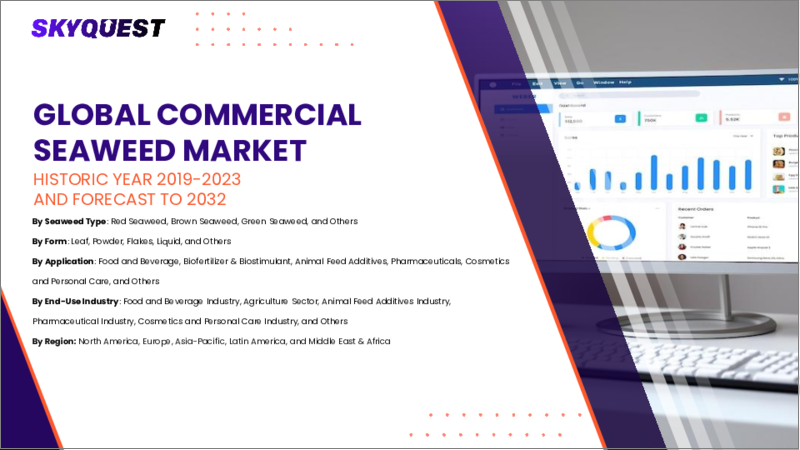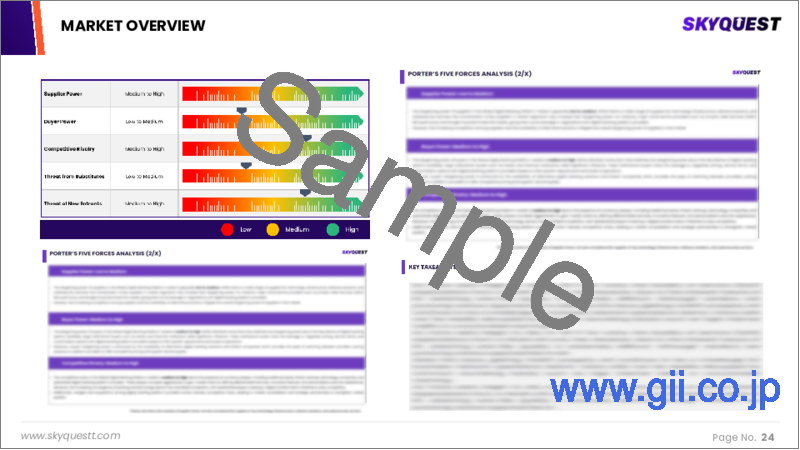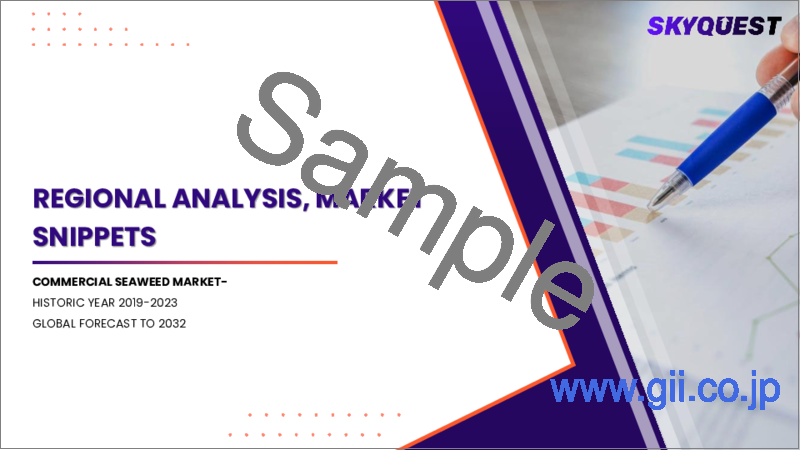|
|
市場調査レポート
商品コード
1603483
商用海藻の市場規模、シェア、成長分析、製品別、形態別、用途別、地域別 - 産業予測、2024年~2031年Commercial Seaweed Market Size, Share, Growth Analysis, By Product (Brown seaweed, Red seaweed), By Form (Leaf, Powdered), By Application (Agriculture, Animal Feed), By Region - Industry Forecast 2024-2031 |
||||||
|
|||||||
| 商用海藻の市場規模、シェア、成長分析、製品別、形態別、用途別、地域別 - 産業予測、2024年~2031年 |
|
出版日: 2024年11月24日
発行: SkyQuest
ページ情報: 英文 157 Pages
納期: 3~5営業日
|
全表示
- 概要
- 目次
商用海藻の世界市場規模は、2022年に104億米ドルと評価され、2023年の106億6,000万米ドルから2031年には129億9,000万米ドルに成長し、予測期間(2024-2031年)のCAGRは2.50%で成長する見通しです。
近年、カラギーナン、アルギン酸、寒天などのハイドロコロイドの需要は、食品、動物飼料、医薬品などさまざまな分野で大幅に増加しています。この使用量の急増は、商用海藻の生産量の増加に対応しており、原料としての藻類の重要性の高まりを浮き彫りにしています。消費者は、大藻製品に関連する健康上の利点をますます認識するようになっており、こうした栄養豊富な原料を毎日の食生活に取り入れるよう促しています。その結果、より健康的で持続可能な選択肢を求める消費者の嗜好の拡大に後押しされ、ハイドロコロイドと海藻ベースの製品市場は継続的な成長が見込まれています。多様な産業におけるハイドロコロイドの多面的な用途は、その多用途性をさらに際立たせ、マーケットプレースにおける藻類資源と海藻製品の増大する流れを利用しようとする利害関係者にとって、ハイドロコロイドを重要な関心分野にしています。
目次
イントロダクション
- 調査の目的
- 調査範囲
- 定義
調査手法
- 情報調達
- 二次データと一次データの方法
- 市場規模予測
- 市場の前提条件と制限
エグゼクティブサマリー
- 世界市場の見通し
- 供給と需要の動向分析
- セグメント別機会分析
市場力学と見通し
- 市場概要
- 市場規模
- 市場力学
- 促進要因と機会
- 抑制要因と課題
- ポーター分析と影響
- 競争企業間の敵対関係
- 代替品の脅威
- 買い手の交渉力
- 新規参入業者の脅威
- 供給企業の交渉力
主な市場の考察
- 重要成功要因
- 競合の程度
- 主な投資機会
- 市場エコシステム
- 技術の進歩
- 規制情勢
- バリューチェーン分析
- ケーススタディ分析
- 顧客と購買基準の分析
- PESTEL分析
- マクロ経済指標
- 市場の魅力指数
- 価格分析
商用海藻の市場規模:製品別& CAGR(2024-2031)
- 市場概要
- 褐藻類
- 紅藻類
- 緑藻類
商用海藻の市場規模:形態別& CAGR(2024-2031)
- 市場概要
- リーフ
- 粉末
- フレーク
商用海藻の市場規模:用途別& CAGR(2024-2031)
- 市場概要
- 農業
- 動物飼料
- 人間の消費
- その他
商用海藻の市場規模:地域別& CAGR(2024-2031)
- 北米
- 米国
- カナダ
- 欧州
- 英国
- ドイツ
- スペイン
- フランス
- イタリア
- その他欧州地域
- アジア太平洋
- 中国
- インド
- 日本
- 韓国
- その他アジア太平洋地域
- ラテンアメリカ
- ブラジル
- その他ラテンアメリカ地域
- 中東およびアフリカ
- GCC諸国
- 南アフリカ
- その他中東・アフリカ
競合情報
- 上位5社の比較
- 主要企業の市場ポジショニング(2023年)
- 主な市場企業が採用した戦略
- 市場の最近の動向
- 企業の市場シェア分析(2023年)
- 主要企業の企業プロファイル
- 会社概要
- 製品ポートフォリオ分析
- セグメント別シェア分析
- 収益の前年比比較(2021-2023)
主要企業プロファイル
- Cargill Inc.
- Roullier Group
- Biostadt India Limited
- Acadian Seaplants Limited
- Gelymar SA
- BrandT Consolidated, Inc.
- Seasol International Pty. Ltd.
- West Coast Marine Bio-Processing Corp.
- Leili Group
- Chase Organics GB Limited
- Indigrow Ltd.
- Travena Organic Solutions Ltd.
結論と推奨事項
Global Commercial Seaweed Market size was valued at USD 10.4 billion in 2022 and is poised to grow from USD 10.66 billion in 2023 to USD 12.99 billion by 2031, growing at a CAGR of 2.50% during the forecast period (2024-2031).
In recent years, the demand for hydrocolloids such as carrageenan, alginate, and agar has significantly increased across various sectors, including food, animal feed, and pharmaceuticals. This surge in usage has corresponded with a rise in commercial seaweed production, highlighting the growing importance of algae as a raw material. Consumers are increasingly aware of the health benefits associated with macroalgae products, prompting them to integrate these nutrient-rich ingredients into their daily diets. As a result, the market for hydrocolloids and seaweed-based products is poised for continued growth, driven by an expanding consumer preference for healthier, sustainable options. The multifaceted applications of hydrocolloids across diverse industries further underscore their versatility, making them a key area of interest for stakeholders looking to capitalize on the increasing flow of algae resources and seaweed products in the marketplace.
Top-down and bottom-up approaches were used to estimate and validate the size of the Global Commercial Seaweed market and to estimate the size of various other dependent submarkets. The research methodology used to estimate the market size includes the following details: The key players in the market were identified through secondary research, and their market shares in the respective regions were determined through primary and secondary research. This entire procedure includes the study of the annual and financial reports of the top market players and extensive interviews for key insights from industry leaders such as CEOs, VPs, directors, and marketing executives. All percentage shares split, and breakdowns were determined using secondary sources and verified through Primary sources. All possible parameters that affect the markets covered in this research study have been accounted for, viewed in extensive detail, verified through primary research, and analyzed to get the final quantitative and qualitative data.
Global Commercial Seaweed Market Segmental Analysis
Global Commercial Seaweed Market is segmented by Product, Form, Application, and region. Based on Product, the market is segmented into Brown seaweed, Red seaweed, and Green seaweed. Based on Form, the market is segmented into Leaf, Powdered, and Flakes. Based on Application, the market is segmented into Agriculture, Animal Feed, Human Consumption, and Others. Based on region, the market is segmented into North America, Europe, Asia Pacific, Latin America and Middle East & Africa.
Driver of the Global Commercial Seaweed Market
The global commercial seaweed market is experiencing significant growth driven by the increasing adoption of seaweed as hydrocolloids in the food industry. With the rising demand for nutritional and functional ingredients, macroalgae are now being integrated into various food products not just in Asia but also in Western nations such as the U.S., France, and Canada, where Asian populations have introduced seaweed into mainstream diets. Seaweed-derived hydrocolloids, including alginate, agar, and carrageenan, enhance the stability and viscosity of foods while serving as effective gelling, emulsifying, and thickening agents in items like ice cream, jams, fruit juices, and baked goods. This trend underscores the growing versatility and appeal of commercial seaweed in enhancing food quality.
Restraints in the Global Commercial Seaweed Market
The Global Commercial Seaweed market faces significant restraints, primarily due to the escalating costs associated with seaweed cultivation. In recent years, increased water contamination from hazardous waste and plastics poses challenges in harvesting from ocean beds, consequently driving up the cost of algae in the market. This high cultivation expense is expected to hinder market growth. A case in point is Alltech's decision to close its Kentucky algae production facility in January 2018 due to concerns about operational efficiency within this business segment. Nonetheless, enhanced government support for macroalgae production aimed at satisfying the growing demand in the food sector may help alleviate these challenges for producers and farmers.
Market Trends of the Global Commercial Seaweed Market
The Global Commercial Seaweed market is experiencing notable growth driven by heightened environmental awareness and a shift in consumer preferences towards sustainable products. As consumers increasingly prioritize eco-friendly options, the demand for macroalgae, which not only offers a rich nutrient profile but also plays a vital role in carbon sequestration, has surged. This rising consciousness around environmental stewardship has catalyzed innovations in seaweed farming and processing technologies. Furthermore, seaweed's versatility as a food source, a biopesticide, and a natural thickening agent in various industries positions it as a key player in the sustainable product market, further enhancing its commercial appeal.
Table of Contents
Introduction
- Objectives of the Study
- Scope of the Report
- Definitions
Research Methodology
- Information Procurement
- Secondary & Primary Data Methods
- Market Size Estimation
- Market Assumptions & Limitations
Executive Summary
- Global Market Outlook
- Supply & Demand Trend Analysis
- Segmental Opportunity Analysis
Market Dynamics & Outlook
- Market Overview
- Market Size
- Market Dynamics
- Driver & Opportunities
- Restraints & Challenges
- Porters Analysis & Impact
- Competitive rivalry
- Threat of substitute
- Bargaining power of buyers
- Threat of new entrants
- Bargaining power of suppliers
Key Market Insights
- Key Success Factors
- Degree of Competition
- Top Investment Pockets
- Market Ecosystem
- Technological Advancement
- Regulatory Landscape
- Value Chain Analysis
- Case Study Analysis
- Customer & Buying Criteria Analysis
- PESTEL Analysis
- Macro-Economic Indicators
- Market Attractiveness Index
- Pricing Analysis
Global Commercial Seaweed Market Size by Product & CAGR (2024-2031)
- Market Overview
- Brown seaweed
- Red seaweed
- Green seaweed
Global Commercial Seaweed Market Size by Form & CAGR (2024-2031)
- Market Overview
- Leaf
- Powdered
- Flakes
Global Commercial Seaweed Market Size by Application & CAGR (2024-2031)
- Market Overview
- Agriculture
- Animal Feed
- Human Consumption
- Others
Global Commercial Seaweed Market Size & CAGR (2024-2031)
- North America, (Product, Form, Application)
- US
- Canada
- Europe, (Product, Form, Application)
- UK
- Germany
- Spain
- France
- Italy
- Rest of Europe
- Asia-Pacific, (Product, Form, Application)
- China
- India
- Japan
- South Korea
- Rest of Asia Pacific
- Latin America, (Product, Form, Application)
- Brazil
- Rest of Latin America
- Middle East & Africa, (Product, Form, Application)
- GCC Countries
- South Africa
- Rest of Middle East & Africa
Competitive Intelligence
- Top 5 Player Comparison
- Market Positioning of Key Players, 2023
- Strategies Adopted by Key Market Players
- Recent Developments in the Market
- Company Market Share Analysis, 2023
- Company Profiles of All Key Players
- Company Details
- Product Portfolio Analysis
- Company's Segmental Share Analysis
- Revenue Y-O-Y Comparison (2021-2023)
Key Company Profiles
- Cargill Inc.
- Company Overview
- Business Segment Overview
- Financial Updates
- Key Developments
- Roullier Group
- Company Overview
- Business Segment Overview
- Financial Updates
- Key Developments
- Biostadt India Limited
- Company Overview
- Business Segment Overview
- Financial Updates
- Key Developments
- Acadian Seaplants Limited
- Company Overview
- Business Segment Overview
- Financial Updates
- Key Developments
- Gelymar SA
- Company Overview
- Business Segment Overview
- Financial Updates
- Key Developments
- BrandT Consolidated, Inc.
- Company Overview
- Business Segment Overview
- Financial Updates
- Key Developments
- Seasol International Pty. Ltd.
- Company Overview
- Business Segment Overview
- Financial Updates
- Key Developments
- West Coast Marine Bio-Processing Corp.
- Company Overview
- Business Segment Overview
- Financial Updates
- Key Developments
- Leili Group
- Company Overview
- Business Segment Overview
- Financial Updates
- Key Developments
- Chase Organics GB Limited
- Company Overview
- Business Segment Overview
- Financial Updates
- Key Developments
- Indigrow Ltd.
- Company Overview
- Business Segment Overview
- Financial Updates
- Key Developments
- Travena Organic Solutions Ltd.
- Company Overview
- Business Segment Overview
- Financial Updates
- Key Developments






